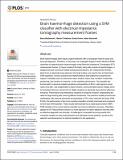| dc.contributor.author | McDermott, Barry | |
| dc.contributor.author | O'Halloran, Martin | |
| dc.contributor.author | Porter, Emily | |
| dc.contributor.author | Santorelli, Adam | |
| dc.date.accessioned | 2018-08-20T10:50:13Z | |
| dc.date.available | 2018-08-20T10:50:13Z | |
| dc.date.issued | 2018-07-12 | |
| dc.identifier.citation | McDermott B, O’Halloran M, Porter E, Santorelli A (2018) Brain haemorrhage detection using a SVM classifier with electrical impedance tomography measurement frames. PLoS ONE 13 (7): e0200469. https://doi.org/10.1371/journal. pone.0200469 | en_IE |
| dc.identifier.issn | 1932-6203 | |
| dc.identifier.uri | http://hdl.handle.net/10379/7514 | |
| dc.description.abstract | Brain haemorrhages often require urgent treatment with a consequent need for quick and accurate diagnosis. Therefore, in this study, we investigate Support Vector Machine (SVM) classifiers for detecting brain haemorrhages using Electrical Impedance Tomography (EIT) measurement frames. A 2-layer model of the head, along with a series of haemorrhages, is designed as both numerical models and physical phantoms. EIT measurement frames, taken from an electrode array placed on the head surface, are used to train and test linear SVM classifiers. Various scenarios are implemented on both platforms to examine the impact of variables such as noise level, lesion location, lesion size, variation in electrode positioning, and variation in anatomy, on the classifier performance. The classifier performed well in numerical models (sensitivity and specificity of 90%(+)) with signal-to-noise ratios of 60 dB(+), was independent of lesion location, and could detect lesions reliably down to the tested minimum volume of 5 ml. Slight variations in electrode layout did not affect performance. Performance was affected by variations in anatomy however, emphasising the need for large training sets covering different anatomies. The phantom models proved more challenging, with maximal sensitivity and specificity of 75% when used with the linear SVM. Finally, the performance of two more complex classifiers is briefly examined and compared to the linear SVM classifier. These results demonstrate that a radial basis function (RBF) SVM classifier and a neural network classifier can improve detection accuracy. Classifiers applied to EIT measurement frames is a novel approach for lesion detection and may offer an effective diagnostic tool clinically. A challenge is to translate the strong results from numerical models into real world phantoms and ultimately human patients, as well as the selection and development of optimal classifiers for this application. | en_IE |
| dc.format | application/pdf | en_IE |
| dc.language.iso | en | en_IE |
| dc.publisher | Public Library of Science | en_IE |
| dc.relation.ispartof | Plos One | en |
| dc.rights | Attribution-NonCommercial-NoDerivs 3.0 Ireland | |
| dc.rights.uri | https://creativecommons.org/licenses/by-nc-nd/3.0/ie/ | |
| dc.subject | TISSUE | en_IE |
| dc.subject | STROKE | en_IE |
| dc.subject | EIT | en_IE |
| dc.subject | CONDUCTIVITY | en_IE |
| dc.subject | DIAGNOSIS | en_IE |
| dc.subject | SYSTEM | en_IE |
| dc.title | Brain haemorrhage detection using a SVM classifier with electrical impedance tomography measurement frames | en_IE |
| dc.type | Article | en_IE |
| dc.date.updated | 2018-08-15T17:19:37Z | |
| dc.identifier.doi | 10.1371/journal.pone.0200469 | |
| dc.local.publishedsource | https://dx.doi.org/10.1371/journal.pone.0200469 | en_IE |
| dc.description.peer-reviewed | peer-reviewed | |
| dc.internal.rssid | 14792804 | |
| dc.local.contact | Barry Mc Dermott, Translational Medical Device Lab, , 2nd Floor Lambe Translational Research Facility,, University College Hospital, , Galway. - Email: b.mcdermott3@nuigalway.ie | |
| dc.local.copyrightchecked | Yes | |
| dc.local.version | PUBLISHED | |
| nui.item.downloads | 378 | |


